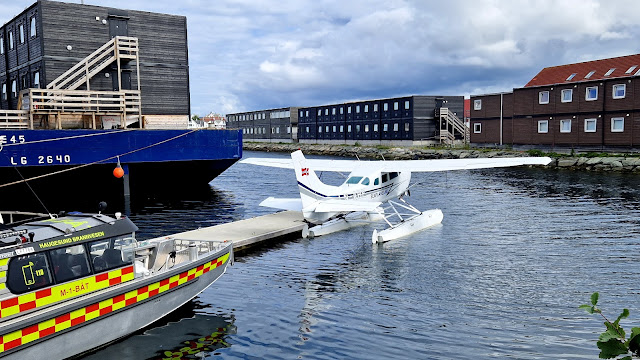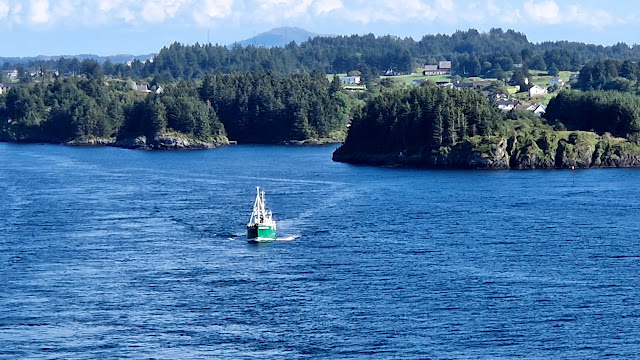On Thursday the 3rd July 2025 I awoke onboard Iona and turned on my cabin TV and got the below picture from the Bridge webcam as we sailed into Haugesund in Norway.
We go up to Horizons for breakfast and sit out on deck taking in the views.
We get the lift down to deck 3 and disembark. We have a look in the souvenir shop right by the mooring and then we walk out into town.
 |
| First time I've ever seen a seaplane, so I had to take a photo! |
Haugesund is a municipality and town on the North Sea in Rogaland county, Norway. As of December 2023, the municipality of Haugesund has a population of 37,855. The vast majority of the population (37,008) live in the Haugesund urban area in the municipality's southwest. Haugesund is the main commercial and economic centre of the Haugaland region in northern Rogaland and southern Vestland. The majority of the municipality outside this area is rural or undeveloped.
We cross the bridge on Risøy bru over the water that separates the dock area and the main town.
We have a quick look about and then we walk back onto Strandgata to catch the bus to The Rising Tides artwork installation. We board the 201 bus and I attempt to pay with a credit card, either cards aren't accepted or the driver didn't understand. Anyway he just told us to get onboard, we travelled a short distance to the GARD bus stop and alight here and we follow the signs that lead us to Haraldshaugen.
After a short walk we reach the coastline.
 |
Haraldshaugen |
Before we walk over to Haraldshaugen we stop and walk up the small mound to Krosshaugen.
Krosshaugen is a stone cross dating from the earliest Christian period in Norway (about 1000 AD). This location has functioned as a Parliament site and the cross may be a monument to the farmers who converted to the Christian faith during sessions of Parliament. It is believed that Christian mass was performed beside these stone crosses before churches were built.
 |
| View to Haraldshaugen from the cross. |
Krosshaugen, one of 60 stone crosses in Rogaland, is also found in this area. The stone cross is from the earliest period of Christianity in Norway. It may commemorate the farmers adopting the Christian faith at the ting assembly, and the Christian mass is also believed to have been read at these stone crosses before a church was built.
We walk on over to Haraldshaugen.
Haraldshaugen was erected to commemorate the unification of Norway by Harald Fairhair. The monument is located at Gard, 2 km north of Haugesund.
Snorre Sturlason’s kings’ sagas make reference to the site where Harald Fairhair was buried, which is believed to have been found last century. The national monument was erected on top of this mound in 1872, to mark the millennium celebration of Norway’s unification into one kingdom.
It was designed by architect Christian Christie, as a large burial mound surrounded by a granite wall with 29 standing stones, each representing one of the old Norwegian counties. A 17-metre granite obelisk with four bronze panels around its base stands at the top of this mound. Each panel depicts important scenes from the life and times of Harald Fairhair.
The coastal path itself is about a 6-km round trip and takes around 1 hour. If you start from Haugesund town centre, you need to add about 30 minutes each way.
We pass some lovely huts framing the shoreline and the North Sea beyond.
We encounter wild goats and George in his eagerness to go say hello to the goats twisted his ankle slightly on uneven ground. After a short rest thankfully he's done no damage.
We walk on passing a path that leads you down to Kvalen fyr, a lighthouse on a peninsula that leads out to sea.
The lighthouse stands proud at the entrance to the Haugesund harbour in Norway. Designed by Severin Aasen, the unlit structure dates back to 1864 and stands 36 meters tall. It is cast in brick and is crowned with a unique “rhomboid” roof. Haugesund Lighthouse is a symbol of the longstanding maritime tradition of the town, and can be seen from Hinna Park, a small park situated behind the Western edge of the town. From here you can observe the lighthouse, as well as many picturesque scenes of the town, including striking views across the estuary. The lighthouse is now an iconic image of the city of Haugesund.

We walk on and the path meets the road (Kvalsvikvegen) which we follow a short way and we reach the Rising Tides statues.
The Rising Tide is a tidal artwork that depicts a series of working horses with riders, which are loosely based on the four horsemen of the Apocalypse. They were originally exhibited in the River Thames positioned within sight of the Houses of Parliament in 2015. Each was submerged and revealed by the tide river twice daily.
The horse’s heads have been replaced by an oil well pump or a “nodding donkey” as they are also known. The suited figures illustrate an attitude of denial or ambivalence towards our current climate crisis and the young riders represent hope in effecting future change.
The sculptures symbolise our desire to control natural forces, but their position in a vast body of moving water highlights our inherent fragility. It is intended to provide a disturbing metaphor for rising sea levels, demonstrating how little time we have to act, yet crucially it offers hope as it resets itself each day, offering us the opportunity for change.
Even though it was fairly busy here, there was still a calming feel to the place.
After taking quite a few photo's , I try to see if I can get a uber taxi back to Haugesund. There are no cars available the app says!
The water was crystal clear and on closer inspection, I could see shrimps and some small fish like gobies.
So we walk back the way we came and once back at the Gard bus stop I book three tickets on the Kolumbus bus app I had downloaded. The bus arrives and we board and travel back to Haugesund town centre.
We get off at the Strandgata/Torggata bus stop and up the road we can see Our Saviours Church.
The church was designed by Architect Einar Halleland. The building is constructed in red-facing-brick and in a neo-Gothic, historical style. The tower is 160 feet high. The church was dedicated in 1901 and can seat 1030 people.
We walk around the many shops and pop in to buy some souvenirs.
The town is situated on a strategically important sound, Karmsundet, through which ships could pass without traversing heavy seas. In the early years, the coastal waters off Haugesund were a huge source of herring, and the town grew accordingly. Despite being barely a village back then, King Harald Fairhair lived at Avaldsnes, very close to the modern town of Haugesund. In the last decades, the town, like its neighbours, has been turning towards the petroleum industry, with the herring being long gone.
After much shopping and walking we decide to head back to the ship.
During the last 20 years, the municipality has established its position as the main trading centre for the Haugaland region and southern parts of Vestland county. It has several relatively large shopping centres, however, this has led to a decline of the trade and shopping activity in the town centre.
We cross back over the bridge we came over earlier, below are buildings connected to the Salted Herrings trade.
Once back onboard we have lunch and relax.
Later that evening we set sail and leave Haugesund and head for a day at sea tomorrow as we are homeward bound back to Southampton.
Despite being a fairly young town, the areas surrounding Haugesund were lands of power during the Viking Age. Harald Fairhair was the first king of Norway. He had his home in Avaldsnes, also known as Homeland of the Viking Kings, only 8 km (4.9 mi) from the present town. After his death in c. 940, it is believed Fairhair was buried at Haraldshaugen, a burial mound adjacent to the Karmsundet strait. This site is the namesake of the town and municipality of Haugesund. The national monument at Haraldshaugen was raised in 1872, to commemorate the 1000th anniversary of the naval Battle of Hafrsfjord in 872. The Battle of Hafrsfjord has traditionally been regarded as when western Norway was unified under a single monarch for the first time.
Haugesund has a strong historical bond to the sea and especially the herring. In the earlier years, the coastal waters of Haugesund were a huge source for fishing herring, and the town grew accordingly. The protective straits of Smedasund and Karmsund gave the town potential to grow in both fishing and shipping. Even to this day, Karmsund is one of Norway's busiest waterways. The town is still growing geographically even though the population has increased only moderately over the last decade. In modern times the herring stocks have been depleted and the town is turning towards the petroleum industry, like its neighbouring town to the south, Stavanger.
That night we had dinner in the main dining room and went to the silent disco, which was anything but. If you took your headphones off the sound of hundreds of people singing was deafening!








































